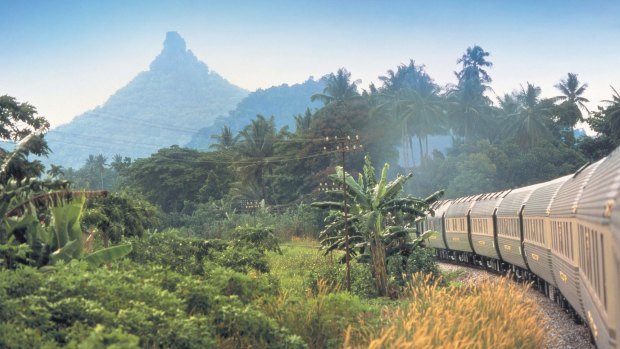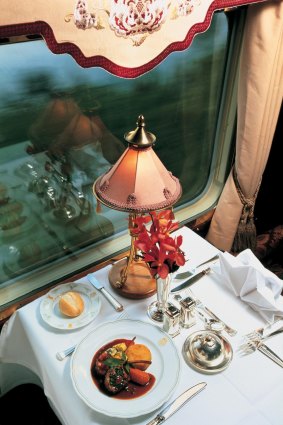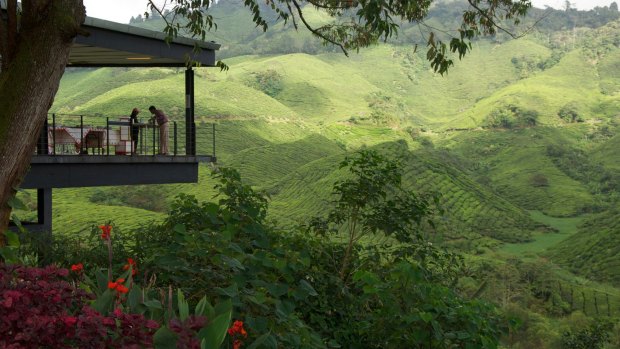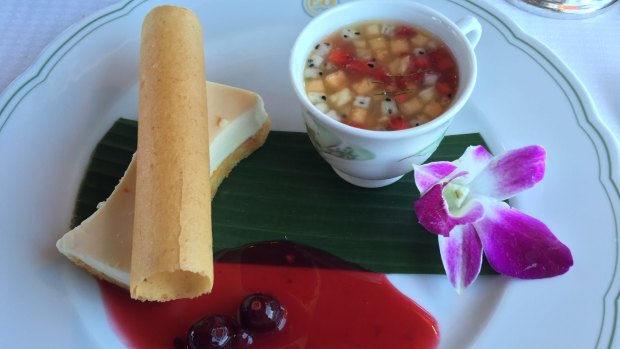This was published 7 years ago
Train tours, south-east Asia: On board the Eastern and Oriental Express from Singapore to Thailand
This is how the journey begins: slowly, cautiously, as though the bones of this train are old and must be treated with great care. And it continues so, a gentle, unhurried voyage through the flushed-with-life landscapes of Malaysia and Thailand.
As we cross the Johor Causeway from Singapore into Malaysia, the Eastern and Oriental Express' train manager makes an announcement: the railways gauge is of the narrow, British colonial type, he says, and so the journey might feel a little jagged in places. Indeed, the train whines and hisses and clatters, as one expects trains to do, but settles into a smooth rhythm once the cities thin out.
There is jaggedness, though, in the transition from gleaming, spotless Singapore to Johor, with its jumble of buildings, mounds of litter, corrugated settlements huddled beside the railway line. Inside the train, our compartment is wood-panelled and air-conditioned and quiet; outside, verges are choked with foliage and life plays out as though on some vast screen placed thoughtfully beside our window: people zipping about on scooters, their faces covered in masks to protect against pollution; labourers churning out bricks at a rail-side brick factory; women harvesting rice from soaked paddies; men clearing spent stalks from mud-caked paddocks.

The bones of this train are old and must be treated with great care.
This incongruity between train and landscape reminds me of the very first rail journey I took, a childhood excursion on the overnight train from Johannesburg to Cape Town. I recall the excitement of stepping into a compartment that smelled of vinyl and sun-dried linen, of listening to the echoing station announcements, of waving at rural children who ran barefoot and laughing beside the train. It was a journey that instilled in me the belief that the world can be observed through the compartment window, that the passing scenes are an unspooling movie reel that reaches its end only once you've arrived at your destination.
Our cabin attendant delivers a tray of afternoon tea: cucumber sandwiches, tiny layer cakes, freshly baked scones. We eat slowly, for there is no hurry – though we're on our way somewhere, we're not going anywhere. The countryside unfurls beside us, a tangle of vegetation – banana plantations, gooseberry trees, soaring coconut palms – disrupted every so often by a car wreck yard, a cemetery, an irrigation canal. Where Singapore's floral arrangements were reined in and obedient, Malaysia's proliferate hither and thither like wild, unruly children.
We travellers are as much a curiosity to the people we pass as they are to us: young men lift their mobile phones and snap photos of the train as it chugs through railway stations; labouring women lift their heads in acknowledgement as we trundle past their fields; children smile and wave as we skirt their school courtyards. I wonder if they can see us sitting there, sipping our tea, or if their view of us is obscured by the reflection of the bright tropical sun on our compartment windows.

The meals are full of fragrant and spicy flavours.
At nightfall the countryside disappears behind an inky gauze and our attention must by necessity turn inwards. All afternoon we have watched this place through panes of glass, and tonight we taste it in the Asian-spiked meals served in the dining car: tom yum cappuccino; hoisin-glazed roasted saba mackerel; ayam rendang biryani with achar; a medley of Asian fruits; tea grown in Malaysia's Cameron Highlands.
It was these fragrant, spicy flavours that drew the train's chef de cuisine, Frenchman Yannis Martineau, to south-east Asia after a decade spent working in restaurants in Europe, the US and South America.
"When I put my feet down here and saw the kind of food they were making I said, 'Wow, this is what I want to learn'," he says.

The Highlands Tea Plantation in Malaysia.
And so Martineau's dishes zing with a sublime fusion of Asian flavour and French sophistication; they reflect, too, the countryside we're passing through: we might eat chicken pendang in Malaysia, green fish curry in Thailand, laksa in Singapore.
But the food is not so unusual as to intimidate travellers.
"On each of my menus I have something everyone will recognise," he says. "The worst thing while travelling is to eat something you've never encountered and feel uncomfortable with."

Carrot cake with mascarpone and fruit salad on the Eastern & Oriental Express.
It's a wonder that Martineau and his small team are able to conjure the flavours of the passing landscape at all: they must work their magic in two tiny galley kitchens, bending and leaning with the movement of a gently rocking train; they must plan their menus in great detail and source quality produce in adequate quantities before departure, for there are few markets or fresh water sources along the way; they must have an emergency menu – and the necessary ingredients – in place should the train be delayed and extra meals required.
We experience Malaysia skin-to-skin next morning, after we've eaten a breakfast of tropical fruit and fresh pastries delivered by truck from Penang. It's summer, and the west coast town of Kuala Kangsar is hot and fragrant and sensuous, just as Martineau's dishes had suggested it would be.
"I'm sure you'll love the weather," says guide Roslyn Lim to those who have come from the northern hemisphere.
"Over there it's freezing cold, over here it's burning hot. Such extremes!"
This is an historic and picturesque royal town, its streets lined with original Malay houses and bungalows, the palaces – one of them built entirely of bamboo – in which to house the sultan and his wives, and the town's masterpiece, the gold-domed Ubudiah Mosque.
Bird cages hang from the houses' eaves, their tiny hostages tweeting their hellos. The houses simmer in the heat. Coconut trees and mango trees proliferate like weeds; here, too, is Malaysia's oldest rubber tree, which gave birth to the rubber industry (once the country's biggest crop, rubber has been replaced by palm oil). Lim shows us a mini star fruit from a wild belimbing tree.
"It is used in all curries, to balance, with its sour taste, the spice," she explains.
These fruits of the peninsula drape themselves down mountain terraces and stretch out in lime-and-lemon-coloured swatches as we progress northwards. The only things moving in the afternoon swelter are the white egrets and a solo motorcyclist and the train, a metallic snake slicing its way across this canvas of vivid green.
The rubber plantations follow us across the border into Thailand; countryside gives way to townships – concrete bridges, corrugated iron shacks, coconut shells piled in a great big heap – and then townships give way to countryside in a rhythmic give-and-take. We enjoy afternoon tea against a backdrop of limestone formations arising from the earth and rolling paddies, some heavy with unharvested fronds, others just a web of cropped stalks cross-hatching the land.
Urban and rural are interchanged again next morning, for when we prise open the blinds we see traffic lined up at intersections in early morning queues. It's late afternoon by the time we reach the outskirts of Bangkok. We stand in the open observation car at the back of the train, feeling the rush of hot wind against our faces, waving to the people who've lined up at crossings on their scooters and bicycles and in their cars and who wait patiently as the train lumbers by.
The ground we've covered has disappeared into the distance now, southern Thailand and the Malay Peninsula and the island of Singapore, but in my mind I can see it all. For this is a slow, deliberate form of travel; it brings to life the landscapes stretching out between the city we've departed from, and the one in which we've just arrived.
FIVE OTHER EATS AND DRINKS TO SAMPLE ALONG THE WAY
BABA-NONYA
Baba-Nonya is a cuisine that emerged from the intermarriage between Malay women and the merchants (mostly Chinese and Indian) who migrated to the Straits of Malacca. Common on the island of Penang, Baba-Nonya fuses the very best of Chinese, Malay and Indian flavours.
SINGAPORE SLING
The E&O Express' Singapore to Bangkok itinerary kicks off with Singapore Slings at Raffles Singapore, where the famous drink was created in 1915. It's made with gin, pineapple juice, grenadine, lime juice, Dom Benedictine, and cherry brandy and Cointreau, which gives it that rosy hue.
MAI TAI
The original mai tai was concocted at Trader Vic's in London in 1944 using rum, curacao, lime juice and sugar syrup. In Bangkok you can order one at Anantara Riverside Resort's very own Trader Vic's – and sip it while watching the riverboats go by.
DURIAN
When durians are in season their "beautiful" scent suffuses the town of Kuala Kangsar, jokes guide Roslyn Lim. In truth, these smelly-but-tasty fruits are banned from many public spaces in south-east Asia due to their offensive odour. The adventurous, however, should try them at least once.
THAI WINE
The E&O Express' wine list includes a drop from Thailand's Hua Hin Hills Vineyard – not because it's a particularly great wine, but because the vineyard deserves credit for giving winemaking a shot in such a challenging climate, says E&O general manager Nicolas Pillet.
TRIP NOTES
FLY
Scoot flies daily from Sydney to Singapore and five days a week from Melbourne to Singapore; economy fares start at $209 and ScootBiz fares from $509 each way. ScootBiz offers spacious leather seats, a 30 kilogram check-in baggage allowance, a premium hot meal, entertainment streamed to your device and other privileges. See flyscoot.com
RAIL
Belmond's Eastern and Oriental Express offers itineraries from Singapore to Bangkok and vice versa. Prices start from around $3500 per person for the three-day/two-night journey based on two people sharing a Pullman cabin and including all table d'hote meals. The train offers around six trips per month from September to the end of its season in April. See belmond.com
Catherine Marshall was a guest of Belmond and Scoot
Sign up for the Traveller Deals newsletter
Get exclusive travel deals delivered straight to your inbox. Sign up now.